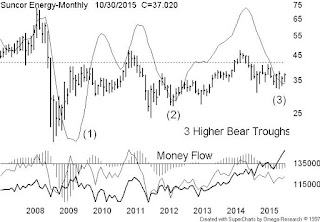The only thing I know about seasonality is during an
uptrend you buy low – sell high and then buy back even higher. In a downtrend
you sell high - buy low and then sell even lower.
December more than any other month is loaded with seasonality folklore
which is recycled annually in the business dailies. The books on seasonality
are published every season and basically say the same thing as last season. The
seasonality bible is the Stock Trader’s Almanac first published in 1967. This
book allowed Mr. Hirsch to distil his lifelong interest in stock market
history, cycles and patterns into a practical working tool for the average
investor. It was the first compilation of the market’s seasonal trends and
tendencies combined with a calendar and laid out for use by non-institutional
investors.
One of the mid December seasonal plays is the “free
lunch” wherein investors tend to get rid of their losing stocks near year-end
for tax purposes. This often has the effect of driving the prices down to near 52-week
lows. The Stock Trader's Almanac has shown that NYSE stocks selling at their
lows on December 15 will usually outperform the markets through the following
late January and early February. I assume the TSX would follow the same model.
Note: This year the energy complex got carpet bombed
with almost panic selling – look for this group to post a big recovery advance
through mid January 2016
Next is the Santa Clause rally which is a short
advance within the last 6-days of December and into the first 2-days of
January. The Almanac
quote is “If Santa Claus should fail to call, Bears may come to Broad and
Wall.”
Then we have the January Barometer which states that
as January goes, so goes the year. The 2010 Almanac claims only 5 errors since
1950 for a 91% accuracy ratio.
Finally we have the January Effect which is the
tendency of the small caps to out-perform the large caps through January as
measured from the Russell 2000 vs. the Russell 1000 index. The Almanac post several reasons for this
seasonal event.



























